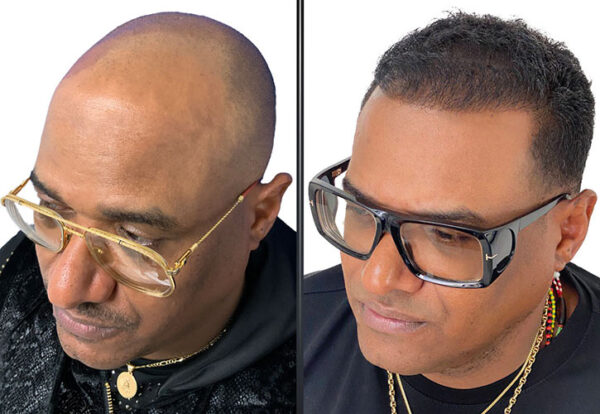
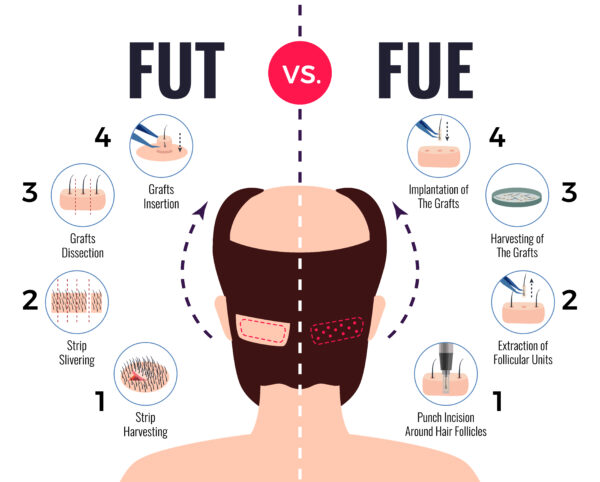
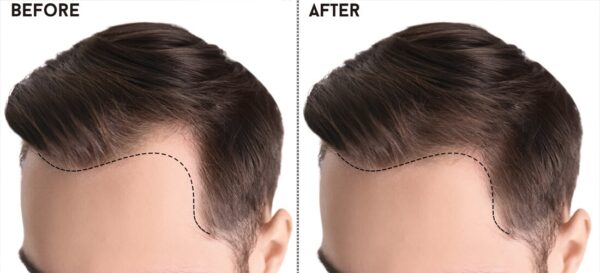
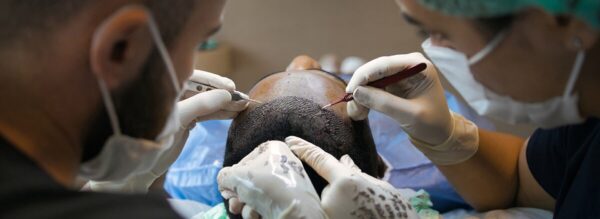

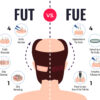
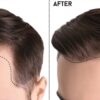
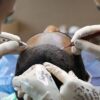

Free
Embark on a transformative journey with our exceptional range of medical treatments. As a leading medical tour operator, we offer a comprehensive selection of world-class treatments and procedures to address your unique healthcare needs. From advanced surgeries to cutting-edge therapies, our team of experienced professionals is dedicated to providing top-notch care and ensuring your comfort and satisfaction. Discover a new level of healthcare excellence with our tailored treatment options. Book now to start your journey towards a healthier and happier you.
Follicular Unit Transplantation (FUT) is a hair restoration technique that involves transplanting hair in naturally occurring groups of 1 to 4 hairs, known as follicular units. FUT is also referred to as the strip procedure because it involves removing a strip of skin from the back or sides of the scalp, which is then dissected into individual grafts. These grafts, consisting of follicular units, are then transplanted into the bald or thinning areas of the scalp.
The advantages of FUT include the ability to transplant thousands of grafts in a single session, maximizing the cosmetic impact of the procedure. FUT is considered an advancement over older hair transplantation methods that used larger grafts, which often resulted in a pluggy and unnatural appearance. When properly performed, FUT results in a natural-looking hair growth pattern that is undetectable as a hair transplant.
The FUT procedure typically involves the following steps:
Preparation: Before the procedure, the patient’s scalp is cleaned, and the donor and recipient areas are marked.
Donor area harvesting: A strip of skin, usually from the back or sides of the scalp, is surgically removed. The size of the strip depends on the number of grafts needed. The incision is then closed with sutures or staples.
Graft dissection: The strip of skin is carefully dissected under a microscope to separate it into individual follicular units. Each unit contains one to four hairs, along with sebaceous glands, nerves, small muscles, and occasional fine vellus hairs.
Recipient site creation: Tiny incisions are made in the recipient area, where the grafts will be transplanted. The surgeon strategically places the incisions to ensure a natural-looking hairline and overall distribution.
Graft transplantation: The dissected follicular units are then transplanted into the recipient sites using specialized instruments. The surgeon ensures proper angulation, direction, and density to achieve a natural appearance.
Postoperative care: After the procedure, the patient may experience some discomfort, swelling, and scabbing in both the donor and recipient areas. Pain medication and antibiotics may be prescribed to manage pain and prevent infection. Follow-up appointments will be scheduled to monitor progress and provide guidance on postoperative care.
Follicular Unit Transplantation (FUT) is suitable for individuals experiencing male pattern baldness or other types of hair loss. It is particularly effective for those looking to restore a receding hairline or fill in balding areas. FUT works best for individuals who have a sufficient donor area, which is typically the back or sides of the scalp, where hair follicles are not influenced by the hormone dihydrotestosterone (DHT), responsible for most hair loss.
During the FUT procedure, a surgeon cuts a strip of skin from the donor area, usually from the back of the head. This strip is then dissected into individual follicular units, which are small groups of hair follicles. These follicular units are then transplanted into the balding or thinning areas of the scalp.
Follicular Unit Transplantation (FUT) may not be suitable for everyone. Here are some factors that may make FUT less appropriate:
Limited donor hair: FUT requires a sufficient amount of donor hair, typically from the back or sides of the scalp, to transplant into the bald or thinning areas. If a person has limited donor hair or has already undergone multiple hair transplant procedures, FUT may not be feasible.
Desire to wear short hairstyles: FUT leaves a linear scar at the donor site, which can be covered by surrounding hair. However, if a person prefers to wear very short hairstyles that expose the donor area, FUT may not be the best option. Follicular Unit Extraction (FUE) or other hair restoration methods that do not leave a linear scar may be more suitable.
Tight scalp or scalp laxity issues: FUT requires the surgeon to remove a strip of skin from the scalp. If a person has a tight scalp or scalp laxity issues, it may affect the ability to safely remove the strip and close the incision properly.
Preference for minimal scarring: While FUT can provide excellent results, it does leave a linear scar at the donor site. If a person is concerned about visible scarring or prefers a minimally invasive approach, they may consider other hair transplant methods like FUE or robotic hair transplantation.
Medical conditions or contraindications: Certain medical conditions or medications may affect the suitability of FUT. It is important to consult with a qualified surgeon who can evaluate your specific circumstances and determine if FUT is appropriate for you.
Follicular Unit Transplantation (FUT) offers several advantages for individuals considering hair restoration. Here are some key benefits of FUT:
Maximizes graft yield: FUT allows for the transplantation of a large number of grafts in a single session. The strip of skin harvested during FUT contains a higher number of follicular units compared to other methods, maximizing the number of grafts available for transplantation. This can result in a more significant cosmetic impact and improved hair density.
Natural-looking results: FUT is known for producing natural-looking results. The use of follicular units, which consist of 1 to 4 hairs, mimics the way hair grows naturally. The surgeon strategically places the grafts to create a hairline and overall distribution that blends seamlessly with the existing hair.
Suitable for extensive hair loss: FUT is particularly suitable for individuals with extensive hair loss or larger areas of baldness. The ability to transplant a higher number of grafts in a single session makes FUT an effective option for covering larger areas of the scalp.
Cost-effective: FUT can be a cost-effective option compared to other hair transplant methods. Since a larger number of grafts can be transplanted in a single session, fewer sessions may be required to achieve the desired results, reducing overall costs.
Long-term viability: The transplanted hair follicles in FUT are typically resistant to the hormone dihydrotestosterone (DHT), which is responsible for most hair loss. This means that the transplanted hair is less likely to fall out over time, providing long-term viability and a lasting solution for hair restoration.
Follicular Unit Transplantation (FUT) is generally a safe and effective procedure for hair restoration. However, like any surgical procedure, there are potential complications and risks associated with FUT. Here are some of the possible complications:
Scarring: FUT involves the removal of a strip of skin from the donor area, which results in a linear scar. The visibility of the scar can vary depending on factors such as the individual’s healing ability, the skill of the surgeon in closing the incision, and the length of the hair surrounding the scar. Although efforts are made to minimize scarring, it is important to consider the potential for a visible scar when opting for FUT.
Numbness and Sensation Changes: Some individuals may experience temporary or permanent numbness or changes in sensation in the donor or recipient areas. This can occur due to nerve damage during the procedure. In most cases, sensation returns to normal over time, but it is important to discuss this potential risk with your surgeon.
Infection: As with any surgical procedure, there is a risk of infection. Following proper postoperative care instructions and taking prescribed antibiotics can help minimize this risk.
Bleeding: Bleeding is a potential complication during and after the FUT procedure. Surgeons take precautions to control bleeding during the surgery, and patients are advised to avoid activities that may increase blood flow to the scalp immediately after the procedure.
Delayed Healing: Some individuals may experience delayed healing of the incision site or the transplanted grafts. Factors such as poor wound care, underlying medical conditions, or individual healing responses can contribute to delayed healing.
Unnatural-looking Results: While FUT is known for producing natural-looking results, there is a possibility of the transplanted hair appearing unnatural if not properly placed or if the hairline design is not well-executed. Choosing an experienced and skilled surgeon can help minimize this risk.
Preoperative care for Follicular Unit Transplantation (FUT) is an essential part of ensuring a successful procedure and optimal results. Here are some key aspects of preoperative care:
Consultation and Evaluation: The first step in the preoperative process is to schedule a consultation with a qualified hair transplant surgeon. During this consultation, the surgeon will evaluate your hair loss pattern, assess the donor area, discuss your goals and expectations, and determine if you are a suitable candidate for FUT.
Medical History and Medication Review: It is important to provide your surgeon with a comprehensive medical history, including any underlying medical conditions, allergies, or medications you are currently taking. Certain medications, such as blood thinners, may need to be adjusted or temporarily discontinued before the procedure.
Smoking and Alcohol: If you smoke or consume alcohol, your surgeon may advise you to refrain from these activities for a certain period before the surgery. Smoking and excessive alcohol consumption can impair healing and increase the risk of complications.
Avoid Blood-Thinning Substances: Your surgeon may instruct you to avoid blood-thinning substances, such as aspirin, nonsteroidal anti-inflammatory drugs (NSAIDs), and herbal supplements, as they can increase the risk of bleeding during and after the procedure.
Hair Care: It is generally recommended to avoid cutting or shaving your hair too short before the procedure. Having some length to the hair in the donor area can help conceal the linear scar that may result from FUT.
Preoperative Instructions: Your surgeon will provide you with specific preoperative instructions to follow. These may include guidelines on when to stop eating and drinking before the surgery, what to wear on the day of the procedure, and any specific hair care instructions.
Arrange Transportation: Since FUT is performed under local anesthesia, you may not require general anesthesia. However, it is still advisable to arrange for someone to drive you home after the procedure, as you may experience some postoperative discomfort or drowsiness.
Postoperative care is crucial for ensuring proper healing and optimal results after Follicular Unit Transplantation (FUT). Here are some key aspects of postoperative care:
Follow Surgeon’s Instructions: It is important to carefully follow the postoperative instructions provided by your surgeon. These instructions may include guidelines on medication usage, wound care, and activities to avoid during the recovery period.
Medication and Wound Care: Your surgeon may prescribe antibiotics to prevent infection and pain medication to manage any discomfort. It is important to take these medications as directed. Additionally, you may be instructed to keep the surgical area clean and apply any recommended topical ointments or dressings.
Avoid Physical Activity: It is generally advised to avoid strenuous physical activities, heavy lifting, and exercise for a certain period after the procedure. This helps prevent excessive sweating, which can interfere with the healing process.
Protect the Transplanted Area: It is important to protect the transplanted area from direct sunlight, extreme temperatures, and trauma. Wearing a hat or using sunscreen with a high SPF can help shield the scalp from harmful UV rays.
Gentle Hair Washing: Your surgeon will provide specific instructions on when and how to wash your hair after the procedure. Typically, a gentle shampoo is recommended, and you should avoid rubbing or scratching the transplanted area.
Avoid Smoking and Alcohol: Smoking and excessive alcohol consumption can impair the healing process. It is advisable to avoid smoking and limit alcohol intake during the recovery period.
Follow-up Appointments: Your surgeon will schedule follow-up appointments to monitor your progress and assess the healing of the transplanted hair. It is important to attend these appointments and discuss any concerns or questions you may have.
Only logged in customers who have purchased this product may leave a review.
Robotic hair transplantation, specifically using the ARTAS Robotic System, is an advanced technique that incorporates robotic technology to assist in hair transplant procedures. The procedure involves several steps:
Consultation and Planning: Before the procedure, you will have a consultation with a qualified hair transplant surgeon. During this consultation, the surgeon will evaluate your hair loss pattern, assess the donor area, discuss your expectations, and determine if you are a suitable candidate for robotic hair transplantation. The surgeon will also use digital imaging and artificial intelligence to simulate possible results during the consultation.
Preparation: On the day of the procedure, your hair will be trimmed to facilitate the imaging and extraction process. Local anesthesia will be administered to ensure your comfort during the procedure.
Robotic Extraction: The ARTAS Robotic System utilizes specialized technology, including a robotic arm and advanced imaging, to precisely extract individual hair follicles from the donor area. The system analyzes and selects the best hair follicles for transplantation based on predetermined criteria.
Recipient Site Creation: After the extraction, the robotic system can create recipient sites in the thinning or balding areas of the scalp. The system uses artificial intelligence algorithms to determine the optimal placement and distribution of the transplanted hair follicles.
Implantation: The extracted hair follicles are carefully implanted into the recipient sites created by the robotic system. The surgeon ensures proper placement and direction of the transplanted follicles to achieve natural-looking results.
Postoperative Care: Following the procedure, you will receive specific postoperative care instructions from your surgeon. This may include guidelines for medication, hair washing, avoiding strenuous activities, and protecting the transplanted area from sun exposure. Regular follow-up appointments will be scheduled to monitor the healing process and address any concerns.
Robotic hair transplantation, specifically using the ARTAS Robotic System, is suitable for individuals who meet certain criteria. While the suitability may vary depending on individual factors and the specific robotic system used, here are some general considerations:
Hair Loss Pattern: Robotic hair transplantation is typically suitable for individuals with male or female pattern hair loss (androgenetic alopecia). The robotic system can accurately extract and implant hair follicles in areas of thinning or balding.
Hair Type: The ARTAS Robotic System is primarily designed for individuals with straight, black, or brown hair. The system utilizes imaging technology to identify and select the best hair follicles for transplantation. Individuals with fair, red, or grey hair may require additional steps, such as dyeing the hair, to facilitate the robotic system’s effectiveness.
Donor Area: The availability and quality of donor hair in the back and sides of the scalp play a crucial role in determining suitability for robotic hair transplantation. The robotic system requires an adequate supply of healthy hair follicles for extraction and transplantation.
Expectations and Goals: It is important for individuals considering robotic hair transplantation to have realistic expectations and goals. The procedure can provide natural-looking results, but it may not achieve the same density as a full head of natural hair. A thorough consultation with a qualified hair transplant surgeon can help assess individual expectations and determine if robotic hair transplantation is suitable.
Medical Evaluation: Before undergoing robotic hair transplantation, individuals may undergo a medical evaluation to assess their overall health and identify any underlying medical conditions that could affect the procedure or recovery.
Robotic hair transplantation, specifically using the ARTAS Robotic System, may not be suitable for everyone. Here are some factors to consider:
Hair Type and Color: The ARTAS Robotic System is primarily designed for individuals with straight, black, or brown hair. Individuals with fair, red, or grey hair may not be suitable candidates as the system relies on the contrast between the hair and the scalp to accurately identify and extract follicles.
Extent of Hair Loss: Robotic hair transplantation is typically suitable for individuals with mild to moderate hair loss. If the extent of hair loss is too extensive, there may not be enough donor hair available for transplantation.
Donor Area Insufficiency: The availability and quality of donor hair in the back and sides of the scalp are crucial for successful transplantation. If the donor area is insufficient or compromised, robotic hair transplantation may not be feasible.
Medical Conditions: Certain medical conditions, such as bleeding disorders or autoimmune diseases, may affect the suitability for robotic hair transplantation. It is important to discuss your medical history with a qualified hair transplant surgeon to determine if the procedure is appropriate for you.
Expectations and Goals: It is important to have realistic expectations and goals for the outcome of the procedure. Robotic hair transplantation can provide natural-looking results, but it may not achieve the same density as a full head of natural hair. A thorough consultation with a qualified hair transplant surgeon can help assess individual expectations and determine if robotic hair transplantation aligns with those goals.
Robotic hair transplantation, such as the ARTAS Robotic System, offers several advantages over traditional manual techniques. Here are some of the benefits:
Precision and Accuracy: Robotic hair transplantation utilizes advanced imaging technology and artificial intelligence algorithms to precisely analyze and select the best hair follicles for extraction and implantation. This results in more accurate placement of grafts, leading to natural-looking results.
Minimally Invasive: Robotic hair transplantation is considered a minimally invasive procedure. It eliminates the need for a linear scar, which is often associated with traditional hair transplant methods. The robotic system uses small punches to extract and implant hair follicles, resulting in tiny, virtually undetectable scars.
Faster Procedure: The use of robotic technology in hair transplantation can significantly reduce the time required for the procedure. The robotic system can automate certain steps, such as follicle extraction and recipient site creation, leading to increased efficiency and shorter procedure times.
Reduced Human Error: The robotic system helps eliminate the risks of human error during the hair transplantation process. It ensures consistent and precise extraction and implantation of hair follicles, reducing the potential for graft damage and improving overall outcomes.
Quicker Recovery: Robotic hair transplantation can offer a faster recovery compared to traditional methods. The minimally invasive nature of the procedure and the precise extraction and implantation of grafts can help reduce postoperative discomfort and promote quicker healing.
Natural-Looking Results: Robotic hair transplantation aims to provide natural-looking results. The precise placement of grafts and the ability to simulate possible outcomes during the consultation phase contribute to a more aesthetically pleasing and harmonious hairline.
Robotic hair transplantation, like any surgical procedure, may have potential complications. However, it is important to note that complications are relatively rare in hair transplantation procedures. Here are some insights from the search results:
Minimal Complications: Hair transplantation, including robotic hair transplantation, is generally considered a safe procedure with very few complications. Most complications can be avoided or minimized through proper surgical technique, wound care, and patient counseling 1.
Donor Area Complications: Complications related to the donor area, such as bleeding, folliculitis, infection, wound dehiscence or necrosis, numbness, and persistent pain, can occur in rare cases. However, these complications can be minimized with proper surgical technique and wound care 1.
Risk of Depletion of Donor Hair: Regardless of whether follicular unit extraction (FUE) is performed manually, with motorized devices, or with robotic punches, there is a risk of clinically apparent depletion of hair from the donor region. This risk is similar to that of donor elliptical harvesting 2.
Nerve Damage and Sensation Loss: In rare cases, nerve damage and loss of sensation may occur in the donor area after robotic hair transplantation 3.
Crusting and Pain: Some patients may experience crusting on the scalp or pain problems in the area of hair transplantation. However, these side effects are generally temporary and can be managed with proper postoperative care 3.
Preoperative care is an important aspect of preparing for robotic hair transplantation. While the specific preoperative care instructions may vary depending on the surgeon and clinic, here are some general considerations:
Medical Evaluation: Before the procedure, you will likely undergo a medical evaluation to assess your overall health and identify any underlying medical conditions that could affect the surgery or recovery. It is important to disclose your complete medical history, including any medications or supplements you are taking.
Medication Adjustments: Your surgeon may provide specific instructions regarding any medications you are currently taking. This may include adjusting or temporarily discontinuing certain medications that can interfere with the procedure or increase the risk of complications.
Avoid Blood Thinners: It is typically advised to avoid blood-thinning medications, such as aspirin or nonsteroidal anti-inflammatory drugs (NSAIDs), for a certain period before the surgery. These medications can increase the risk of bleeding during the procedure.
Smoking and Alcohol: It is generally recommended to refrain from smoking and consuming alcohol for a specified period before the surgery. Smoking can impair healing, while alcohol can interfere with the effectiveness of anesthesia and increase bleeding risks.
Hygiene and Hair Care: Your surgeon may provide specific instructions regarding hair washing and scalp hygiene before the procedure. It is important to follow these instructions to ensure a clean and optimal surgical environment.
Fasting: Depending on the type of anesthesia used, you may be instructed to fast for a certain period before the surgery. This helps reduce the risk of complications related to anesthesia.
Arrangements for Transportation: Since the procedure may involve the use of anesthesia, it is advisable to arrange for someone to drive you home after the surgery.
Postoperative care plays a crucial role in the recovery and success of robotic hair transplantation. While the specific postoperative care instructions may vary depending on the surgeon and clinic, here are some general considerations:
Medication and Wound Care: Your surgeon will provide instructions regarding any medications that need to be taken after the procedure. This may include antibiotics to prevent infection and pain medications to manage any discomfort. It is important to follow the prescribed medication schedule and adhere to wound care instructions, such as keeping the scalp clean and avoiding excessive touching or scratching.
Rest and Physical Activity: It is advisable to take it easy and avoid strenuous activities for a few days after the procedure. This includes avoiding heavy lifting, intense exercise, and activities that may increase blood flow to the scalp. Your surgeon will provide specific guidelines regarding when you can resume normal activities.
Avoiding Sun Exposure: Direct sun exposure to the scalp can be harmful during the initial healing phase. It is important to protect the scalp from the sun by wearing a hat or using sunscreen with a high SPF.
Avoiding Hair Styling Products: For a certain period after the procedure, you may be advised to avoid using hair styling products or applying excessive heat to the scalp. This allows the newly transplanted hair follicles to heal and settle in their new location without any interference.
Follow-Up Appointments: Your surgeon will schedule follow-up appointments to monitor your progress and assess the healing process. It is important to attend these appointments and communicate any concerns or questions you may have.
Patience and Expectations: It’s important to have realistic expectations and understand that the results of hair transplantation take time. It may take several months for the transplanted hair follicles to start growing and for the final results to be visible. It’s important to be patient and follow your surgeon’s guidance throughout the recovery process.
There are no reviews yet.
Only logged in customers who have purchased this product may leave a review.
Choosing the right hospital and physician are important factors to consider that significantly influence a patient’s treatment. The preferred choice for many patients is choosing private care.
Choosing the right hospital and physician are important factors to consider that significantly influence a patient’s treatment.
Reviews
There are no reviews yet.